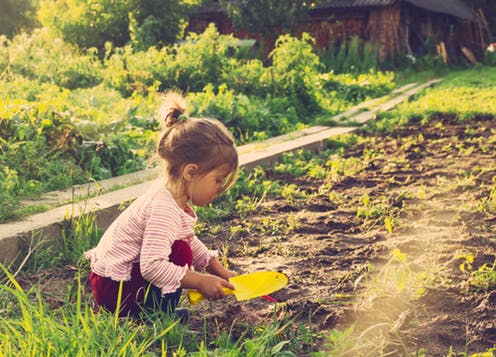
Source: Shutterstock.com, via https://theconversation.com/being-in-nature-is-good-for-learning-heres-how-to-get-kids-off-screens-and-outside-104935
There has been a boom in advice for parents and guardians over the last few days about what they can do with their children for the upcoming weeks – and probably months – off school. In my position as a geography teacher, outdoor educator, orienteering coach, and father of two young children, I have some experience at knowing what might work well, and in what context. Please find below some thoughts and suggestions on how to combine educating and entertaining your children in and around the home in these challenging times.
The basics
Work within the structure that your children’s school has put in place for remote working. One of the reasons why most school days are divided into different lessons of between 35 and 60 minutes in duration, is because learning, and especially learning in childhood, is more effective in short bursts and when it is ‘interleaved‘, i.e. with learners encountering different subjects and topics throughout the school day, week and term. But be aware that in a school-based day, children ‘depressurise’ between lessons by chatting to their friends whilst they physically move around the school site; you could replicate this by allowing them 5 minutes to contact their friends and/or to move around (see below for some really short ideas).

Source: https://www.learningscientists.org/interleaving
Children thrive on variety, and this might mean doing several activities in one day – perhaps interspersed by periods of playing educational and not-so-educational computer games and watching CBeebies/CBBC/YouTube (delete as appropriate!).
Be flexible: be willing to go off on a tangent if your child takes you on one!
Keep it simple. Younger children in particular can let their imagination run wild with things as simple as chalk, clean paintbrushes and den-building materials – see below for some easy ideas.
Don’t splash the cash. You don’t need to spend lots of money: use your school or public library if it is still open, visit charity shops, and where possible, share toys, books and other materials with other families, taking care to disinfect them if necessary.
Use technology judiciously. Although your children may not like to admit it, they will probably be overdosing on it. This is not only because most schools will be expecting your child to use technology to receive, undertake and submit work, but also because in place of face-to-face socialising in school, your children will probably want to use social media even more frequently than usual.
Make the most of mealtimes together, and build preparation into your time together (see below). My children are on the fussier end of the spectrum, so eating together can be a frustrating experience, but at least we have time to talk about things and you might even wheedle out some of their worries (coronavirus included).
Now we have covered some of the basics, what about some practical ideas?
Outdoors
Some people will be able to leave the house, as long as they maintain social distancing protocols – the main one of which is to stay about 2m from other people. And, most of the time in spring and summer, the increasingly clement weather and lighter days should facilitate this. The summer term is when many schools run outdoor learning activities and field trips, and the current shutdown means that children are in danger of missing out on these valuable opportunities. It is important to keep the outdoor flame burning – in all its inquisitive, active, resilience-building, messy, muddy, invigorating glory. (Inspired by Nicholas Tampio, I reflect on why face-to-face learning works here.)
Some of the simplest ideas for the youngest children in your household involve art – for example, paintbrushes dipped in water provide a surprisingly entertaining distraction, and investing in jumbo chalks gives children free rein over your patio and walls:
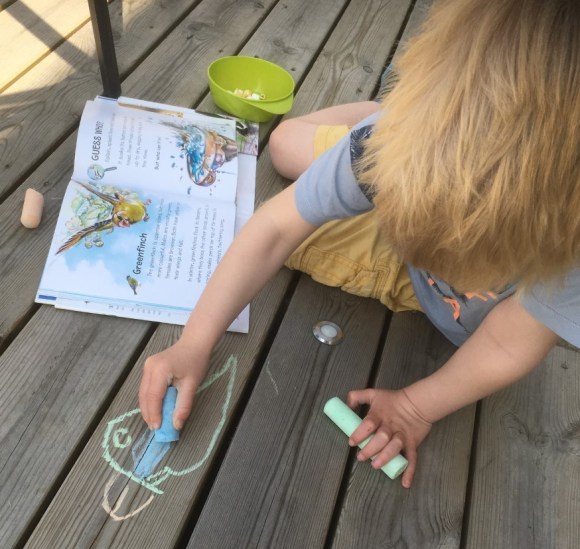
For older children, why not inspire them into producing outdoor artworks in the style of Andy Goldsworthy? The Art department at Bradford Grammar School develop this idea in the annual Year 9 Outdoor Learning Day:

Easy activities, like gardening, can be tailored into learning opportunities. These activities include the building of a ‘bug hotel’, and planting bulbs (it’s not too late for some varieties) and vegetables. The RSPB – which nowadays has a remit which has spread towards the conservation of all wildlife – has many great ideas on their website. If this inspires you, then it is good to know that anyone can join the RSPB at a subscription rate of your own choice, after which you will receive a folder of activities to do in any season, plus one of two age-appropriate quarterly children’s magazines containing other activities.
The time is also ripe for children in Key Stages 1-3 in particular to undertake many of the zany activities developed by the Mission:Explore collective. Some of their books and ideas are available to download for free on websites such as this one or this one, or to buy on Amazon. Their Facebook page and Twitter account contain archives of many of their activities. One example is below:

The Scout Association are, of course, experts at outdoor learning, and this page contains hundreds of outdoor ideas, sortable by time, cost and group size:
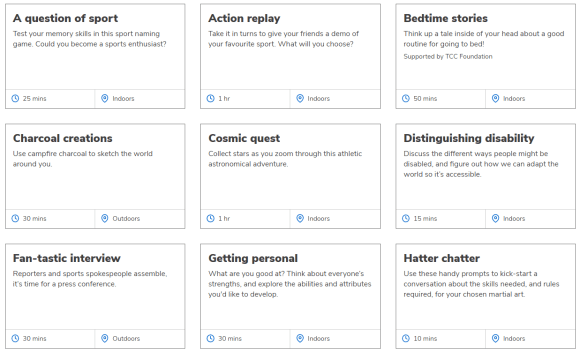
Going out for a walk in the local park or woods may be enough to stimulate your children – and those of any age will need little prompting to make dens or dam brooks. It has been proven that spending time in green spaces – and especially forests – is great for mental health. One way of embracing this opportunity is to undertake walking meditation – or what some Buddhists call ‘forest bathing’. Bradford Grammar students have tried this in the last two outdoor learning days:
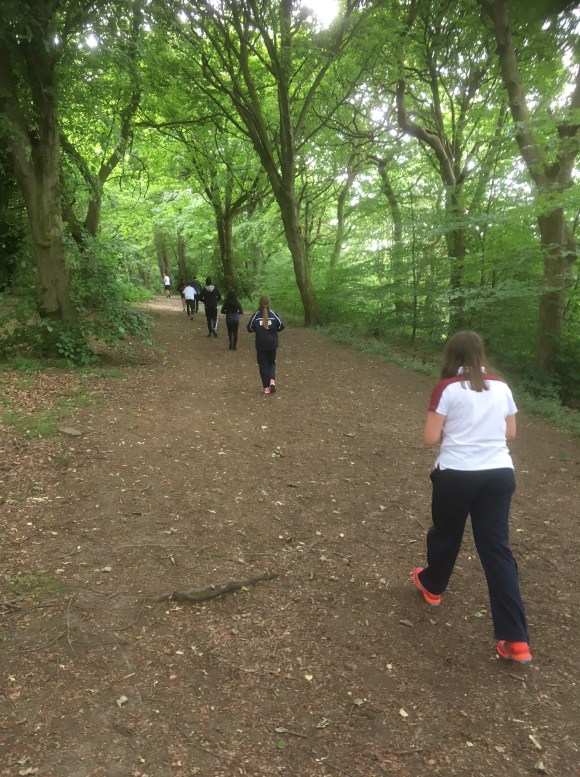
To introduce more intellectual challenge into such trips, why not find and print an orienteering map of these areas, and use it to plan your way around routes of increasing complexity. There are hundreds of so-called ‘permanent orienteering courses’, with posts to visit – some of which have QR codes to scan to prove you have been to each location – and to add to the challenge, why not run them? See the British Orienteering website for more information.
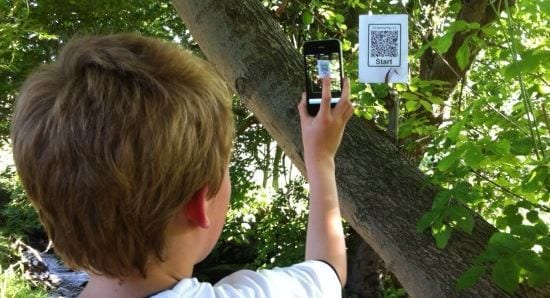
There are more outdoor learning ideas in the Outdoor Classroom Day website – and in some of my earlier blog posts, such as this one. Finally, the ‘hive mind’ of the Bradford Grammar School staff helped in the collection of outdoor learning activities covered here.
Indoors
Much of the day will, either by choice or necessity, be spent indoors.
Simple pleasures such as reading, practising a musical instrument, or jigsaws, will undoubtedly see a rise in popularity in the coming weeks. The art of letter-writing, perhaps to an elderly relative, or to friends, may well make a comeback too.
There should be more time for meal planning and preparation in the coming weeks too. Making a pizza dough, then leaving it to rise, then knocking it back, adding toppings, then putting it in the oven, then waiting again for it to cook, is an easy way to engage children in the structure (and fun) of cooking, as well as teaching them patience! Older children could also benefit from some home economics practice as part of their move towards independence.
What could pupils do to fill the gaps between lessons, aside from engaging in social media? Rationing mobile phone usage may well be the best policy, as evidence shows that even having a phone in one’s field of vision can reduce productivity. So what about those low-tech activities? Picking up a new physical skill in small doses may be worthwhile – I remember learning to juggle in the five-minute gaps between revision for my GCSEs back in the ’90s! Engaging in an intense intellectual activity such as a crossword could also be an outlet for older students: more able ones could even learn the art of the cryptic crossword.
As well as their outdoor provision, The Scouts have produced a section on their website called ‘The Great Indoors’, containing over a hundred ideas. See below:

For those looking to model real-world phenomena and processes, I recommend a web search for ‘kitchen geography’. Have a look at this video, for instance, which recreates glacial erosion in your own home!
There will be other people with more experience than me in the arena of arts, crafts and music-making, so I will leave my suggestions here for now.
Good luck, and I hope to be able to put more out there in the coming weeks. As ever, I welcome your thoughts.
David
2 replies on “Education and entertainment? Occupying children in challenging times”
Well written, good sense. @GASPC
LikeLiked by 1 person
Thanks Stephen!
LikeLike